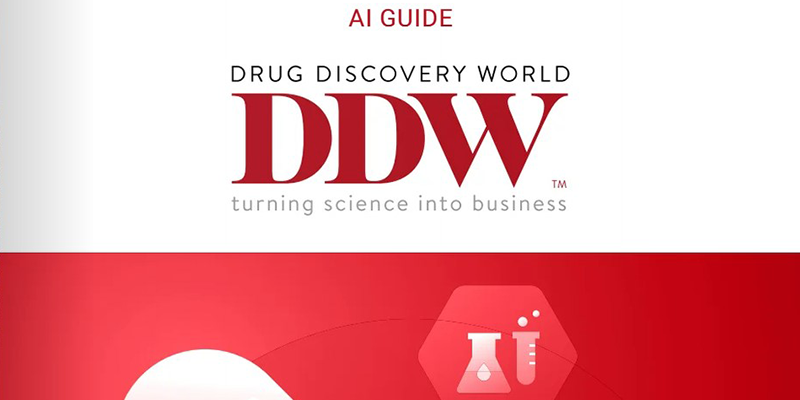NEWS:
AI Guide in DDW Fall 2025
How AIDDISON™ and SYNTHIA© Are Transforming Molecular Design

September 29, 2025
In the latest issue Fall 2025 of Drug Discovery World (DDW) on page 35 the new AI Guide is featuring the case study “Empowering Drug Discovery.” It highlights how artificial intelligence (AI), machine learning (ML), and advanced cheminformatics are transforming the landscape of drug discovery.
Why Read This Guide?
If you’re a scientist, innovator, or decision-maker in pharma or biotech, this guide is essential reading. It goes beyond the hype to show how AI is making a measurable impact—from accelerating molecule design to optimizing clinical trials. You’ll learn what works, what challenges remain, and how to harness AI’s full potential through collaboration, data quality, and responsible innovation.
From Hype to Real-World Impact
The cost of bringing a drug to market now exceeds $2.3 billion (page 37), with timelines often stretching past a decade and a 90% failure rate in clinical trials. AI is changing this equation. Deloitte’s 2024 survey found that 62% of biopharma executives believe AI could cut early discovery timelines by at least 25%. AI-designed molecules have already entered Phase I trials within just 12 months of program initiation—a dramatic acceleration.
Breakthrough Technologies and Applications
The guide highlights advances in deep learning, generative AI, cloud computing, and multiomics data. Tools like CRISPR-GPT on page 37 are automating gene-editing design, while AI-powered digital pathology is streamlining global clinical trials. AI is now central to hit discovery, de novo molecule design, lead optimization, and even clinical trial planning.
SYNTHIA® and AIDDISON™: Accelerating Discovery and Synthesis
Part of this transformation are platforms like AIDDISON™ and SYNTHIA®. AIDDISON™ is a secure, web-based solution that combines AI/ML and computer-aided drug design (CADD) to accelerate the identification and optimization of new drug candidates. Its intuitive interface makes advanced computational tools accessible to scientists of all backgrounds.
AIDDISON™ generates thousands of viable molecules using similarity searches, pharmacophore screening, and generative models. It then applies property-based filtering, molecular docking, and shape-based alignment to prioritize molecules with the highest probability of biological activity and optimal ADMET profiles.
What truly sets AIDDISON™ apart is its seamless integration with SYNTHIA® Retrosynthesis Software. SYNTHIA® enables researchers to immediately assess the synthetic accessibility of promising molecules and identify necessary reagents for laboratory synthesis. By bridging the gap between virtual molecular design and practical synthesis planning, SYNTHIA® and AIDDISON™ empower chemists to innovate faster and with greater confidence.
Case Study: Tankyrase Inhibitors
A recent application note on tankyrase inhibitors—a class of molecules with potential anticancer activity—demonstrates the power of this integrated approach. Starting from a known inhibitor, AIDDISON™’s generative models and virtual screening explored vast chemical space, producing diverse candidate molecules. These were filtered and docked to the target protein, and the most promising structures were sent to SYNTHIA® for retrosynthetic analysis. This workflow accelerated the identification of novel, synthetically accessible leads and enabled a more thorough exploration of chemical space than traditional methods.
Expert Insights and Collaboration
Interviews with leaders like Rabia Khan, CEO and Founder of Serna Bio. on page 43 and Dr Amanda Hemmerich, Global Director of Digital Pathology Innovation at IQVIA Laboratories on page 46, reveal how AI is unlocking new therapeutic strategies, especially in RNA-targeted therapies and digital pathology. These stories show how AI is enabling scientists to ask bolder questions and tackle diseases that were previously out of reach.
Challenges and the Path Forward
The guide doesn’t shy away from hurdles—data quality, reproducibility, regulatory uncertainty, and the need for FAIR data principles. Industry collaborations and new standards are helping overcome these barriers, ensuring that AI delivers real-world impact.
The Future: AI as an Enabler, Not a Replacement
AI’s role in drug discovery is no longer hypothetical. It’s a present and accelerating force. The next wave of breakthroughs won’t come from AI replacing scientists, but from AI enabling them to ask bolder questions, test more ambitious hypotheses, and ultimately bring better medicines to patients faster and more efficiently.
